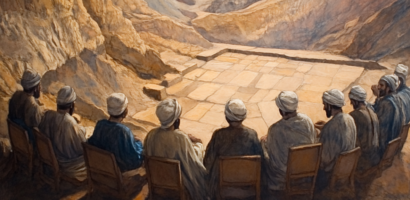Alan Crown (1932-2010) was one of Australian Jewry’s greatest intellectuals. He made contributions to Australian Jewish historiography, notably by means of extended monographs on Australian Zionism and the Jewish press, but his main fields of scholarly attainment lay elsewhere. Born and educated in Leeds, he served in the British army and had a stint as a schoolmaster in Britain and Australia, but once he joined the Semitic Studies department at Sydney University in 1962 he developed a reputation as a Hebraist and Bible scholar and in time became a world authority on Samaritan Studies and the Dead Sea Scrolls.
Summary of the article: Estimates of when the Samaritans finally separated from the Judeans vary widely. I argue that there are reasons to date that separation only to the period when it was possible to see the Samaritans as religiously and politically distinct from the Jews. In many respects the Samaritans of the first century were a Jewish sect, but we can trace a gradually changing relationship between Judeans and Samaritans. It was only in the generation after Judah ha-Nasi, following the Bar Kokhba revolt, that we see the development of anti-Samaritanism in a series of negative statements by the rabbinical teachers, culminating in the ruling that the Samaritans are unquestionably to be considered as Gentiles. Likewise there is evidence from the church fathers that in the first and second centuries the Samaritans were regarded as Jews. One obvious cause of the increasing tension between the Samaritans and the Judeans of the Second Temple period was the fact that the Samaritans had a temple of their own on Mt. Gerizim, which was a serious rival to the one in Jerusalem. However, rivalries were kept within bounds until both the Samaritans and the Judeans lost their temples. This gave full play to other complex factors which led to an irreconcilable breach. The trigger for the schism might well have been the development of heretical, rather than schismatic Samaritanism, with a separate Pentateuch which included the specific characteristics that we have come to recognize as Samaritan, the development of a chain of synagogues, and the establishment of a liturgy and a series of midrash schools for the development of the Samaritan halakhah. These developments took place in the third century CE. To download the article in PDF click here.
To receive more information about learning Biblical Languages with Hebrew University of Jerusalem/eTeacher Biblical program online at affordable cost, please, click here.
© By Eli Lizorkin-Eyzenberg, Ph.D.
To sign up for weekly posts by Dr. Eli, please, click here. It is recommend by Dr. Eli that you read everything from the begining in his study of John. You can do so by clicking here – “Samaritan-Jewish Commentary”.





Although I already had this article, I thank you for posting it up for others!
You are most welcome, James! eli
[…] One of the reasons for only considering the Gospel of John according to its traditional interpretation has to do with a lack of familiarity with the large body of Samaritan scholarship. This scholarship shows the Israelite Samaritans were as much included under the inner-Israelite umbrella as the rest of what is today – referred to as Jewish movements of the Second Temple period. If the reader uncritically accepts the definition of who the Israelite Samaritans were from anti-Samaritan sources such as the writings of Josephus; it would be impossible to see what we are suggesting. On the other hand, if the Ancient Samaritans are also allowed the right of self-definition and therefore placed on the map of Israelite movements in the time of Jesus, this would open a way for a completely different reading of the Gospel of John. (For a very serious student of Israelite polemic, please, visit this page.) […]